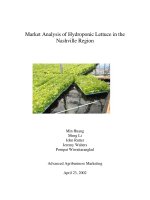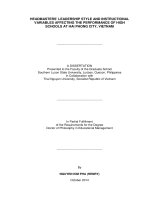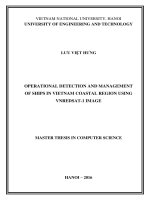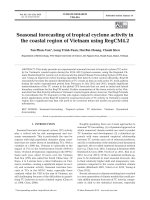Performance of heat tolerant clones of potato in tropical coastal region of India
Bạn đang xem bản rút gọn của tài liệu. Xem và tải ngay bản đầy đủ của tài liệu tại đây (241.66 KB, 7 trang )
Int.J.Curr.Microbiol.App.Sci (2020) 9(8): 2961-2967
International Journal of Current Microbiology and Applied Sciences
ISSN: 2319-7706 Volume 9 Number 8 (2020)
Journal homepage:
Original Research Article
/>
Performance of Heat Tolerant Clones of Potato in
Tropical Coastal Region of India
S. Sunitha1*, V.K. Gupta2, Shirly Raichal Anil1 and J. Suresh Kumar1
1
ICAR-Central Tuber Crops Research Institute, Thiruvananthapuram, Kerala, India
2
ICAR-CPRI, Regional Station, Modipuram, Meerut-250001, UP, India
*Corresponding author
ABSTRACT
Keywords
Potato, Heat
tolerance, Tropical
potato, Marketable
tuber yield, Sensory
evaluation
Article Info
Accepted:
24 July 2020
Available Online:
10 August 2020
Potato is a cool weather crop, with temperature being the main limiting factor on
production; however it grows under a diverse range of climatic conditions. The vegetative
growth of the plant is best at a temperature of 24°C while tuber development is favoured at
18°C. Hence, potato is grown as a summer crop in the hills and as a winter crop in the
tropical and subtropical regions. To extend this crop in tropical regions of our country heat
tolerant advanced clones of promising crosses developed at ICAR-CPRI, were
evaluated/screened during 2016-17 in tropical coastal soils at ICAR-CTCRI,
Thiruvananthapuram, Kerala, India. Five advanced hybrids and two released heat tolerant
varieties from ICAR-CPRI were evaluated at ICAR-CTCRI, during 2016-17 in Rabi
planting season. Higher total tuber yield was obtained in the advanced hybrids HT/71329(28 tha-1), HT/10-2002(25 tha-1) as compared to heat tolerant variety Kufri Surya (20
tha-1). Selected genotypes had acceptable texture and taste without bitterness due to
alkaloids in organoleptic test conducted after harvest. The taste and crispiness of fried
chips was also good for HT/10-2002 followed by HT/7-1329, compared to Kufri Surya.
Introduction
Potao (Solanum tuberosum L.) holds the
position of fourth most consumed food crop
globally after rice, wheat and maize. This is
the most important starch rich crop cultivated
in more than 2/3rd countries from the
temperate to sub tropics and is a rich source
of low fat carbohydrates. Potatoes are often
the main source of income and food security
in developing countries. It is one of the basic
crops which significantly impact nutritive
status of nearly two billion people around the
world. The total world production of potato is
estimated at 388.19 mt in 2017 (FAO stat,
2019). India ranks second only to China, in
terms of production, commanding a share of
nearly 12.5% of the world's output. In 2017,
India produced 48.61 MT of potatoes (FAO
stat, 2019).
Potato cultivation is limited to relatively
cooler areas and seasons throughout the world
due to photo and thermo sensitivity of the
crop. It is grown only under such conditions
where the temperature during the growing
seasons is moderately cool. Temperatures
above 30°C can have a range of negative
2961
Int.J.Curr.Microbiol.App.Sci (2020) 9(8): 2961-2967
effects on potato, including slowing tuber
growth and initiation, less partitioning of
starch to the tubers (Levy and Veilleux,
2007). The vegetative growth of the plant is
best at a temperature of 24°C while tuber
development is favoured at 18°C. High
temperature stress in potato lowers tuber yield
both through reduction in the assimilate
supply and reduced partitioning of assimilates
to tubers (van Dam et al., 1996). The major
effect of night temperature is on carbon
partitioning among various plant parts, with
temperatures above 18 °C favouring diversion
of carbon towards the above ground parts at
the cost of tubers, making the plants grow
very tall and reducing harvest index (Wolf et
al., 1990).
Potato is grown almost in all states of India.
However, the major potato growing states are
Himachal Pradesh, Punjab, Uttar Pradesh,
Madhya Pradesh, Gujarat, Maharashtra,
Karnataka, West Bengal, Bihar and Assam. In
India about 80% of the potatoes are grown in
north-western Indo- Gangetic plains during
winter from October to February. About 10%
are grown in Himalayas and Nilgiri hills
during summer and only 7% in the warmer
plateau region during rainy season as well as
winter (Pandey et al., 2007). Temperature
being the limiting factor, the planting time
varies from region to region. Temperature is
the most limiting factor for cultivation of
potato. The crop needs less than 24oC night
temperature for proper tuberisation which
limits its cultivation under tropical conditions.
However, efforts are now being taken up to
develop tropical potato varieties so that
cultivation is possible in non traditional areas
also, especially during winter season. The
initiation of this tuber is triggered by short
day lengths (photoperiods), and involves
growth hormones. The colder the soil
temperature, the more rapid the initiation of
tubers and the greater the number of tubers
formed. The optimum soil temperature for
tuber initiation is 59 to 68˚F (15 to 20˚C).
(Anonymous, 2016).
Heat tolerance is by far the least important
trait in adopted varieties, as just a few
varieties present in India have a high
tolerance to heat. However, in absolute terms
high tolerance deserves future attention given
the likely negative impact of warmer
(extreme) temperatures on potato production
(Willy, 2019). Hence, the present study aimed
to evaluate the performance of heat tolerant
clones of potato in tropical coastal region of
India.
Materials and Methods
A field experiment was conducted at ICARCentral Tuber Crops Research Institute,
Thiruvananthapuram, Kerala, during 2016-17
to evaluate heat tolerant genotypes of potato.
Five heat tolerant advanced clones of
promising crosses of potato developed at
ICAR- Central Potato Research Institute,
Regional Station, Modipuram, Meerut were
evaluated/screened in tropical coastal soils
along with two control variety, Kufri Surya
and Kufri Lauvkar. The soil in the
experimental area was deep, well drained,
sandy clay loam, moderately acidic in
reaction (Table 1). The minimum and
maximum temperature prevailed during the
growing season were also noted (Fig. 1). Five
clones evaluated were HT/7-1329, HT/101554, HT/10-1559, HT/10-2002, HT/10-2816
along with released heat tolerant varieties,
Kufri Surya and Kufri Lauvkar. Healthy,
fifteen uniform sized tubers each were planted
on ridges taken at 60 cm spacing giving 20
cm plant to plant distance. The crop was
planted on 14th December 2016 and
harvested on 20th March, 2017. The tubers
were planted at a depth of 4 inches on ridges.
Organic manure @ 15 tonnes and a fertilizer
dose of 180-80-100 kg of N, P2O5 and K2O
per hectare were applied. Organic manure in
2962
Int.J.Curr.Microbiol.App.Sci (2020) 9(8): 2961-2967
the form of FYM @ 150 g and vermi compost
@ 50g per plant were applied as basal dose.
Nutrients in the form of urea, single super
phosphate and muriate of potash were applied
following standard recommendation. Half of
the nitrogen and full phosphorus and
potassium were applied as basal and the rest
half of nitrogen, one month after
establishment of the crop. The crop was
irrigated daily by drip method after one week
of planting near to field capacity.
Observations on sprouting of tubers and
establishment of plants were recorded. The
yield attributes such as number of tubers per
plant, mean tuber yield and total tuber yield
per plot were recorded at harvest. The tubers
were graded into marketable (> 20g) and non
marketable (< 20g) and the yield per hectare
was assessed. Morphological characters of
tubers and the sensory evaluation of the chips
fried from tubers was also assessed following
standard procedures.
Results and Discussion
Sprouting of tubers
The crop started sprouting within a week after
planting. Tubers of HT/7- 1329 germinated
first taking only 7 days, followed by HT/ 101559 within 9 days. HT/ 10-1554 took 16
days for first sprouting. There is 100%
sprouting for all the genotypes. 100%
sprouting is achieved in HT/ 7-1329 within 18
days and in other clones, it ranges from 21-24
days. Number of days taken for sprouting in
different clones is depicted in Fig. 2.
Normal sprouting time for potatoes planted in
the soil ranges from 14 to 28 days, depending
on the cultivar and soil and weather
conditions. Early sprouting and establishment
of the genotype HT/ 7-1329 showed its
adaptability to the temperature range of 3032oC maximum and 24-27 oC minimum
temperature prevailed during the first three
weeks after planting. The control Kufri Surya
took 21 days for 100% establishment.
Yield and yield attributes
Number of tubers per plant
Tuber number ranged from 4.5 to 8 in
different clones at the time of harvest.
Maximum number is recorded in Kufri Surya
(8.0) closely followed by HT/ 7-1329 (7.5).
Minimum number of tubers is recorded by
Kufri Lauvkar (4.6).
Mean tuber yield per plant
Mean tuber yield per plant ranged from 63 g
in Kufri Lauvkar to 330 g in HT/ 7-1329.
HT/10-2002 also recorded more yield (298 g)
than the control (238 g).
Total tuber yield
Maximum tuber yield per ha is noted in HT/
7-1329 (27.5 tha-1) followed by HT/10-2002
(24.8 tha-1). Performance of Kufri Lauvkar is
noted for poor yielder and recorded only 5.28
tha-1 (Fig. 3).
Marketable tuber yield
Marketable tuber yield per ha was also
maximum in HT/ 7-1329, followed by HT/102002. Small sized tubers, which are
nonmarketable, was maximum in Kufri
Lauvkar. Kufri Surya produced 14.7 tha-1 of
marketable tubers. In HT/ 7-1329 and HT/102816, 24.2 % of total tuber yield was culled
out for non marketability. In Kufri Surya,
25.8 % was found nonmarketable.
HT/7-1329 and HT/10-2002 recorded 38%
and 25% increase in tuber yield over the
control variety Kufri Surya, indicating that
these varieties perform well even at a night
2963
Int.J.Curr.Microbiol.App.Sci (2020) 9(8): 2961-2967
temperature of 24 to 28oC prevailed during
the experiment period (Fig. 4).
The most widely used selection strategy to
identify heat tolerance is to evaluate
genotypes in a heat stress environment and to
select those that have superior yields as
compared to cultivars with better performance
under these conditions (Wahid et al., 2007).
Minimum temperature and maximum
temperature varied from 23 to 27oC and 30-32
o
C during the crop period. Temperature being
the first determinant which determines the
suitability for cultivation of potato, minimum
temperature below 18° C and maximum
temperature below 30° C are ideal and these
temperatures should prevail for sufficient
number of days for the potato to tuberize and
give economically viable yield (Minhas et al.,
2011). When heat tolerance is introduced in
any crop, an increase in the range of
temperatures favourable for that crop occurs,
consequently leading to increase in the
thermally suitable period for crop growth. Of
the genotypes tested, HT/7-1329 and HT/102002 were found promising under high
temperature regimes of tropical situations.
Table.1 Physical and chemical properties of the soil (top 30 cm) in the experimental area
Sand Silt
(%) (%)
7
69
Physical
Clay FC
(%) (%)
24
14.5
WP
(%)
5.8
BD
pH
(g/cc)
1.30 5.2
Chemical
EC
OC Available Nutrients (kg/ha)
(ds/m) (%) N
P
K
0.08
0.59 365
55
160
Table.2 Performance of heat tolerant genotypes of potato on yield attributes and yield
Sl No
1
2
3
4
5
6
7
Genotypes
HT/7-1329
HT/10-1554
HT/10-1559
HT/10-2002
HT/10-2816
K. Lauvkar
K. Surya
No. of
tubers
/plant
8.0
7.5
5.2
5.1
5.1
5.0
4.6
Marketable
tuber yield
(t/ha)
20.83
4.44
3.47
18.19
13.89
1.94
14.72
Total tuber
yield(t/ha)
27.5
11.94
16.25
24.86
18.33
5.28
19.86
Table.3 Morphological characteristic of fresh potato tubers
Variety
HT/7-1329
HT/10-1554
HT/10-1559
HT/10-2002
HT/10-2816
Kufri Lauvkar
Kufri Surya
Shape
Oval
Round
Oval
Round
Oval
Round
Oval
Skin colour
White
Light Yellow
White
White
White Cream
White Cream
Light Cream
2964
Position of eyes
Shallow eye
Shallow eye
Shallow eye
Shallow eye
Shallow eye
Shallow eye
Shallow eye
Flesh colour
White
Light Yellow
Cream
Cream
Yellow
Yellow
Yellow
Int.J.Curr.Microbiol.App.Sci (2020) 9(8): 2961-2967
Table.4 Sensory evaluation parameters of fried chips from tubers
Variety
HT/7-1329
HT/10-1554
HT/10-1559
HT/10-2002
HT/10-2816
Kufri Lauvkar
Kufri Surya
Texture
Mealy
Mealy
Mealy
Mealy
Mealy
Mealy
Mealy
Appearance
Good
Very Good
Excellent
Very Good
Very Good
Fair
Good
Aroma
Moderate
Moderate
Moderate
Much
Much
Much
Slight
Test
Good
Very Good
Very Good
Very Good
Very Good
Very Good
Very Good
Bitterness
Absent
Absent
Absent
Absent
Absent
Absent
Absent
Fig.1 Minimum and maximum temperature (weekly) prevailed from planting to harvest
Fig.2 Percentage sprouting in different cultivars after planting
Fig.3 Total and Marketable tuber yield of different genotypes
2965
Int.J.Curr.Microbiol.App.Sci (2020) 9(8): 2961-2967
Fig.4 % Increase/ Decrease in total/ marketable tuber yield of clones compared to Kufri Surya
The minimum temperature varied from 23 to
25oC during the tuberising period of the crop.
Kufri Surya, the first heat tolerant variety
released from ICAR-CPRI, Shimla, even
those is found suitable in situations where
minimum temperature is 20° C and even 22°
C (Minhas et al., 2011). Present study
indicates that the two genotypes HT/7-1329
and HT/10-2002 can tuberise even at a
minimum temperature regime of 23-25oC and
give satisfactory tuber yield. The results are in
agreement with other researchers who
investigated that tuber yield varies
significantly with variety and location
(Gebreselassie et al., 2016, Preetham, 2018)
Morphological and sensory evaluation of
tubers
Morphological characteristic of fresh potato
tubers and the sensory attributes grown under
tropical conditions recorded in Table 3 and 4.
The taste and crispiness of fried chips was
also good for HT/10-2002 followed by HT/71329, compared to Kufri Surya. Selected
genotypes had acceptable texture and taste
without bitterness due to alkaloids in
organoleptic test conducted after harvest. The
influence of location and cultivars on quality
of potato tubers have been reported by
researchers (Uppal and Paul, 2001; Kumar et
al., 2003).
In conclusion with growth in the world
population and rising temperatures, more heat
tolerant cultivars are going to be needed in
near future. Two clones i.e., HT/7-1329 and
HT/10-2002 were found suitable to cultivate
in tropical regions during rabi season based
on the studies conducted. It has also been
observed that by selecting suitable tuber crop
as inter crop would further help to reduce
effect of high temperatures in potato during
crop growth. Effective management of
bacterial wilt and sucking pests would be
helpful to expand this crop in the tropical
coastal regions. This study reveals that potato
cultivation would become feasible in many
locations in Kerala with the deployment of the
heat tolerant varieties similar to or better than
Kufri Surya. However, agro techniques are to
standardised for these varieties including deep
planting in the cool moist soil layer, frequent
irrigations to lower the soil temperature,
proper mulching etc for realising full potential
of a variety.
Acknowledgement
The authors acknowledge the support given
by Dr. S.K. Chakrabarti, Director, ICARCPRI, Shimla, for undertaking the study.
References
Anonymous 2016. www.krishisewa.com van
Dam, J., Kooman, P.L. and Struik, P.C.
2966
Int.J.Curr.Microbiol.App.Sci (2020) 9(8): 2961-2967
1996. Effect of temperature and
photoperiod on early growth and final
number of tubers in potato, Potato Res.
39: 51-62. FAO stat. 2019. www. FAO
stat.org.
Kumar, D., Ezekiel, R. and Khurana S.M.P.
2003. Effect of location, season and
cultivar on the processing quality of
potatoes. J. Indian Potato Assoc., 30,
247-251.
Levy, David and Veilleux, R. E. 2007.
Adaptation of Potato to High
Temperatures and Salinity - A Review,
American Journal of Potato Research,
84 (6): 487–506.
Minhas J.S., Rawat, S., Govindakrishnan
P.M. and Kumar D. 2011. Possibilities
of enhancing potato production in nontraditional areas, Potato J. 38 (1): 14-17.
Pandey, N.K., Pandit, A., Chandran, K.P. and
Pandey, S.K. 2007. Potato statistics:
India and world, CPRI Technical
Bulletin No. 81, Central Potato
Research Institute, Shimla. Pp. 121.
Preetham, Ashwini and Pavan 2018.
Evaluation of Potato Varieties for their
Suitability under Northern Telangana
Agro
Climatic
Conditions,
Int.J.Curr.Microbiol.App.Sci. 7(4): 400406.
Uppal, D.S. and Khurana, S.M.P. 2001.
Chipping performance of potato
varieties grown at different locations. J.
Indian Potato Assoc., 28, 233-236.
Wahid, A., Gelani, S., Ashraf, M. and Foolad,
M.R. 2007. Heat tolerance in plants: An
overview,
Environmental
and
Experimental Botany. 6, 199–223.
Willy Pradela, Marcel Gattob, Guy Hareaua,
S.K. Pandey, Vinay Bhardwayd 2019.
Adoption of potato varieties and their
role for climate change adaptation in
India, Climate Risk Management. 23,
114–123.
Wolf, S., A. Marani and J. Rudich 1990.
Effect of temperature and photoperiod
on assimilate partitioning in potato
plants, Ann. Bot. 66, 513-20.
How to cite this article:
Sunitha, S., VK. Gupta, Shirly Raichal Anil and Suresh Kumar, J. 2020. Performance of Heat
Tolerant Clones of Potato in Tropical Coastal Region of India. Int.J.Curr.Microbiol.App.Sci.
9(08): 2961-2967. doi: />
2967









